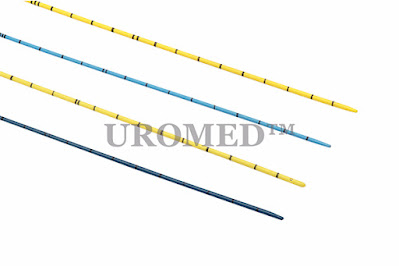Catheter manufacturers
The
PCN catheter was
originally described by urologist Dr Willard Goodwin in 1955 as a minimally
invasive, x-ray guided temporary or permanent procedural alternative to
traditional surgery in patients with hydronephrosis. Catheter manufacturers using clinical data
find four broad indications for a PCN placement, which are; first for the
relieving of urinary obstruction, second, diagnostic testing, third for access, for therapeutic interventions, and
fourth urinary diversion.
 |
| PCN catheter |
Relief
from urinary obstruction is the most common cause for PCN catheter placement
representing 85 to 90% of recipients. The top three causes of renal obstruction
in adults are iatrogenic benign stricture, urinary stones, and malignancy. From
imaging, diagnoses can be made with computed tomography (CT), ultrasound,
magnetic resonance imaging (MRI), or nuclear medicine of renal obstruction.
Ultrasound is usually option one due to high sensitivity for detecting a
dilated collecting system, relative availability, and minimal risk. However, as
opposed to other methods of imaging, it is not as effective in identifying the etiologic
location of the obstruction. Non-contrast CT can effectively detect hydronephrosis
and has the added benefit of being highly sensitive for the detection of
obstructing stones in exceptionally large patients with renal impairment. For
people with normal urinary function, contrast-enhanced computed tomography has
a very high success ratio in finding the cause of hydronephrosis. Because an
uninfected obstructed kidney is not seriously threatened, as a rule, PCN catheter placement is an urgent rather than emergent process. Clinical data suggest
that complete recovery of the glomerular filtration rate (GFR) happens within a
week. Percutaneous nephrostomy is the process of inserting a small, flexible rubber tube (catheter)
through the skin into the kidney to drain urine. A
catheter is a flexible tube made of Teflon, latex, or silicone and can be
inserted into the body creating a channel, from within, for the entry of a
medical device, or passage of fluid to
the exterior. For many years, the epidermal catheters used were ordinary tubes
made of available industrial compounds, and design was largely based on current
need.
Advancements
in material technology and medical science have created new technical
challenges for medical devices applied in minimally invasive interventional
procedures. Medical apparatus companies are making devices that are more
complex, less cumbersome, less invasive, and multifunctional, which require
tighter tolerances from their contract manufacturers and greater precision. For
instance, in the extrusion business, device companies continue to develop
complex new designs for single products that require co-extrusion, variable
coil/braid reinforcements, multi durometer segments, or multi-lumen. Progressively
complex designs, tooling, materials, and prototyping all pump-up costs, yet
cost-saving needs to be designed into the final product, without compromising function
or quality. One way of achieving this is by speeding up the manufacturing
process by improving efficiencies, automation, and reducing waste. Another
means would be to partner with someone skilled in the practice of designing
for manufacturability; that is, designing products and processes that remove
certain steps, such as assembly and finishing.
A catheter can be inserted or placed into a body
cavity, duct, or vessel. Functionally, they perform a wide variety of tasks
depending on the type of catheter, they provide access by surgical instruments,
drainage, and, administration of fluids or gases. Procedurally, catheterization is the process of inserting a catheter. Made of Teflon, latex, or
silicone, catheters are thin, flexible tubes, and are available in varying
levels of rigidity depending on the purpose. A catheter reposed inside the
body either permanently or temporarily is called an indwelling catheter. There
are many different types of catheters, for many different purposes, and we will
look at the different types and functions in another article

Comments
Post a Comment